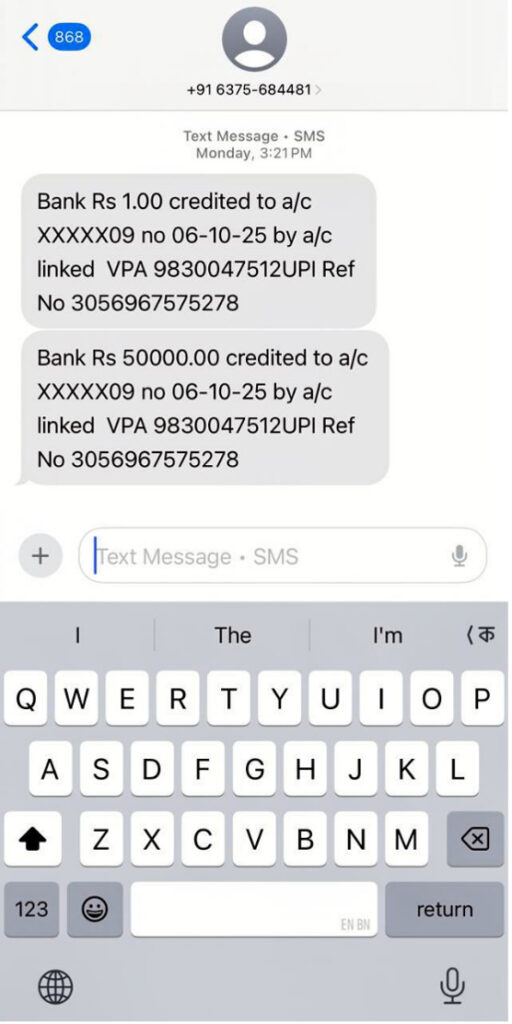Mini Perveen, a young girl in remote Purnia, Bihar—one of India’s most underdeveloped districts—recently discovered her niche by selling embroidered artwork online.
One lazy afternoon, she received a call from an unknown number. The caller claimed to have seen her products online and wanted to place a large order for an upcoming festival season. She was thrilled.
To confirm her payment details, he sent a one-rupee test transfer to her account. Immediately, she received a text message. While still conversing with her on the phone, he said he had made the payment in advance for her products. Moments later, she received another text—a fake alert mimicking her bank’s format—showing a large deposit of Rs 50,000 (about USD $600).
He claimed that by mistake, he had made an overpayment that must be returned to him. But in the moment before making the final call for the refund, she realized that the bank account number displayed in the phone message did not match her actual bank account number. She had just narrowly escaped a deceitful online transaction.
Every day, hundreds of Indians fall prey to such scams. The deception lies not in sophisticated coding but in trust manipulation, exploiting limited digital literacy and the human tendency to believe what looks official. As more first-time users come online, digital inclusion without digital safety risks turning empowerment into vulnerability.
Beyond Connectivity: Building Digital Capacity
India’s rapid digitalization has been remarkable. Affordable data, public service portals, and digital payments have expanded faster than ever. But connectivity and processes alone do not guarantee capability. The digital divide today is not just about who is online; it’s about who can navigate, trust, and benefit from being online.
Programs like the Pradhan Mantri Gramin Digital Saksharta Abhiyan (PMGDISHA)—a government digital literacy program, the Bangla Sahayata Kendras (digital kiosks in West Bengal), and community Wi-Fi projects in Northeast India are helping bridge these gaps by offering assisted digital services, user-friendly language, and on-ground operator support.
Yet, the journey remains uneven, especially for women, older adults, and rural entrepreneurs who need sustained training, awareness, and ethical safeguards.
Bridging this divide requires a shift from connectivity to capability—from counting connections to nurturing confidence. Community-centered initiatives, digital skills workshops, and locally managed service hubs can make the Internet safer and more empowering. When citizens understand both opportunity and risk, they can use the web not just to consume but to create, question, and contribute.
The Other Divide: Safety and Dignity Online
The digital divide is not only about access. It’s also about safety and dignity online. While connectivity offers opportunity, many experience the Internet as a space of vulnerability.
Women, minorities, and marginalized communities face trolling (online posts intentionally made to provoke or upset someone), hate speech, gendered abuse, and privacy violations that silence them.
Women journalists such as Rana Ayyub and Barkha Dutt in India have endured coordinated harassment designed to discredit them. Even public figures like actors and musicians are not immune. True inclusion requires not just access, but digital ethics, empathy, and accountability.
According to a 2023 commentary by the Observer Research Foundation, gendered trolling in India has become a systemic form of online abuse, where women journalists, activists, and public figures face orchestrated attacks designed to shame and silence them.
India continues to face one of the widest gender gaps in digital access in South Asia. 79% of Indian men own mobile phones compared to only 43% of women, and just 24% of Indian women have access to smartphones. Even among those with a device, a mere 11% of women use the Internet regularly. This inequality in access compounds another crisis: online safety.
Studies show that women, girls, and LGBTQI+ individuals are disproportionately targeted by trolling, harassment, and other forms of online violence, revealing how access without safety reinforces, rather than resolves, existing social divides.
Digital Etiquette as a Public Good
Digital etiquette is the new civic responsibility of the connected world. Just as traffic rules keep roads safe, digital etiquette safeguards dignity online. It goes beyond good manners. It’s about ensuring that digital spaces remain inclusive, respectful, and trustworthy.
The principles are simple but vital: pause before forwarding unverified or harmful content; show patience with first-time users still learning digital tools; design for accessibility, including multiple languages and low bandwidth; uphold privacy by default; and engage in respectful online dialogue even during disagreement.
Practicing these norms transforms connectivity into a culture of care, where the Internet becomes safer, more equitable, and truly democratic.
Towards an Equitable Digital Future
The Internet’s promise lies in its inclusivity and its ability to give voice and visibility to those long excluded from power and privilege. But realizing that promise demands not just access, but agency.
Digital inclusion must move beyond technology. It is both technological and societal. True empowerment requires four key shifts.
i) Connectivity must be affordable and reliable, which we can achieve through community networks, shared spectrum, and last-mile access.
ii) Digital public infrastructure must be accessible, with multilingual portals and assisted access points.
iii) We must expand women’s digital access through targeted policies and skill programs, creating powerful ripple effects for families and communities.
iv) Finally, we must treat digital literacy and etiquette as civic essentials—skills as fundamental as reading and writing to ensure that connectivity leads to capability, safety, and shared progress for all.
As India connects its last mile, it must also connect the last mind, ensuring that every new user gains not only a signal but also the skills and safeguards to thrive in a digital world. Connectivity builds bridges. Capability keeps them strong.
Image © Ranjana Rajput via Unsplash

